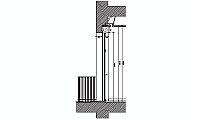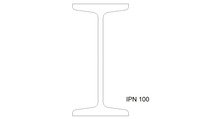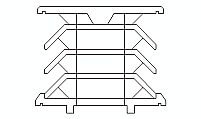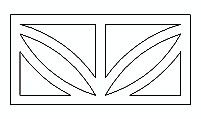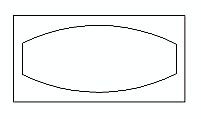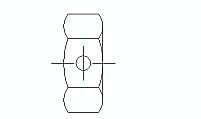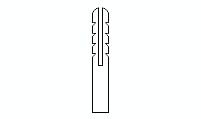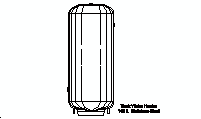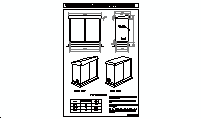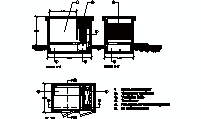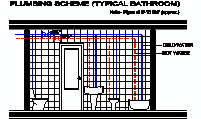CAD Blocks categories
 3D models
3D models home furniture
home furniture sanitary ware - bathrooms
sanitary ware - bathrooms professional equipment
professional equipment doors and windows
doors and windows people and animals
people and animals plants and trees
plants and trees vehicles - transports
vehicles - transports architectural details
architectural details mechanical - electrical
mechanical - electrical urban planning - civil works
urban planning - civil works safety health construction
safety health construction accessible design
accessible design drawing sheet
drawing sheet signals
signals construction machinery
construction machinery accessories and objects
accessories and objects maps and street maps
maps and street maps
Curved Roofing Tiles Front View - Free CAD Block

size: 4 kb
category: architectural details
related categories:
description: front view of curved roofing tiles arranged with proper overlap to prevent water ingress, commonly used in traditional roofing systems.
file extension: .dwg CAD - AutoCAD software
Curved Roofing Tiles: Comprehensive Guide
Overview of Curved Roofing Tiles
Curved roofing tiles, often referred to as barrel tiles or mission tiles, are a hallmark of traditional architecture in various regions. Their distinctive shape facilitates efficient water runoff and adds an aesthetic appeal to structures. The front view showcases the convex surface, which, when installed with appropriate overlap, ensures a watertight seal. This design has been perfected over centuries to combine functionality with timeless beauty.
These tiles are predominantly used in Mediterranean countries such as Spain, Italy, and Greece, where they complement the regional architectural styles. In the United States, similar tiles are popular in areas with Spanish or Italian architectural influences, particularly in states like California and Florida. Their enduring appeal lies in their ability to blend with both historic and contemporary designs.
Standard Dimensions of Curved Roofing Tiles
The typical dimensions of curved roofing tiles vary depending on regional standards and manufacturer specifications. Common lengths range from 17 to 20 inches (430 to 500 mm), with widths between 6 to 7 inches (150 to 180 mm). The curvature radius is designed to facilitate proper overlapping during installation, which is crucial for effective water drainage and structural integrity.
Manufacturers like Tejas Borja offer models such as the C-50.21, which measures 19.7 inches in length and 8.3 inches in width, providing flexibility in overlap to suit various roofing requirements. These dimensions are carefully engineered to ensure compatibility with different roofing systems and to maintain the aesthetic harmony of the structure.
Installation Techniques for Curved Roofing Tiles
- What is the proper overlap for curved tile installation?
- A minimum overlap of 3 inches (75 mm) is recommended to ensure water tightness and structural stability.
- Are mechanical fasteners necessary for installation?
- Yes, using hooks or clips can enhance the attachment, especially in areas prone to high winds or seismic activity.
- Can curved tiles be installed on any roof slope?
- They are best suited for slopes between 20° to 40°; steeper slopes may require additional fastening methods.
- Is underlayment required beneath curved tiles?
- Installing a waterproof underlayment is essential to provide an additional barrier against moisture penetration.
- How are curved tiles maintained over time?
- Regular inspections for cracks or displacement, along with cleaning to remove debris, will prolong the lifespan of the roofing system.
Advantages of Curved Roofing Tiles
Curved roofing tiles offer several benefits, including excellent durability and resistance to harsh weather conditions. Their shape promotes efficient water runoff, reducing the likelihood of leaks and water damage. Additionally, the natural air pocket formed between the tiles and the roof deck provides insulation, enhancing energy efficiency by regulating indoor temperatures.
From an aesthetic perspective, these tiles add a classic and elegant appearance to buildings, increasing curb appeal and potentially boosting property value. Their versatility allows them to be used in various architectural styles, making them a preferred choice for both restorations of historic buildings and new constructions aiming for a timeless look.
Historical Significance and Modern Usage
The use of curved roofing tiles dates back to ancient civilizations, where they were crafted from clay and used extensively in regions around the Mediterranean. Their design was not only functional but also reflected the cultural artistry of the time. Over centuries, the manufacturing process has evolved, incorporating advanced materials and technologies to enhance performance while preserving the traditional aesthetic.
In contemporary architecture, curved tiles are embraced worldwide for their blend of historical charm and modern practicality. While they remain prevalent in Europe, their adoption in other parts of the world, including the United States, has grown, especially in areas seeking to emulate Mediterranean or Spanish Colonial styles. This global appreciation underscores their enduring appeal and adaptability to various climatic conditions and design preferences.



